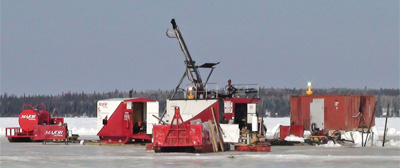 The second biggest drilling company in the world just got a little bigger.
The second biggest drilling company in the world just got a little bigger.
Major Drilling of Moncton, New Brunswick, has acquired the Bradley Group of Rouyn-Noranda, Quebec, for $80 million, expanding its footprint in Quebec, Ontario and several international markets.The acquisition adds 124 rigs and 841 employees to Major Drilling’s inventory of 571 rigs and 4,362 employees.“The acquisition of Bradley Group is a unique opportunity to further Major Drilling’s corporate strategy of focusing on specialized drilling, expanding our geographic footprint in areas of high growth and maintaining a balance in our mix of drilling services,” said company president and CEO Francis McGuire. “The operations of both companies are very complementary in terms of geography, personnel and strategies.”
Major Drilling now has a presence in three cities in Northern Ontario, including pre-existing offices in Sudbury and Thunder Bay and the former Bradley Group operations centre in Timmins.
Until now, drill rigs in northeastern Ontario that required major repairs or overhauls were sent to a Major Drilling repair centre in Winnipeg, but as a result of the acquisition, that work will shift to Timmins, said McGuire.
The purchase of Bradley Group also provides Major Drilling with a presence in the Philippines and boosts the company’s profile in Colombia, Mexico and Surinam.
Boart Longyear remains number one in the world, but “not by very much,” at least in terms of coring drills, said McGuire. “They also do a lot of reverse circulation, sonic and big rotary drilling in the tar sands that we don’t do.”
No layoffs are anticipated.
“We’re in an industry that is desperately short of people, so we need every single person we can keep,” said McGuire. “We’re very busy. People will often ask if we have drills, but that’s not the issue. Do we have the crews to man the drills? That’s the issue. The fact is we could have quite a few more rigs working in Canada if we had the people.”
Major Drilling has an aggressive training program, but it takes three to five years to train a good driller, noted McGuire.
“People don’t understand how variable the ground is. You need to learn the techniques for all of the different situations. That’s why it takes so long.”
McGuire is optimistic about the outlook for the drilling business.
In most industries, it’s the demand side that’s critical, but in the mining industry, supply is equally important, said McGuire.
“We’re in an industry that’s driven by a lack of reserves,” he pointed out.
The widening gap between demand and supply in the mining industry is caused by the fact that most of the big mines operating today were found in the ’80s with the introduction of aerial survey technology, he said. Most of those mines are now 30 years old and are either closing or faced with mining lower grade ore.
“Here in New Brunswick, (Xstrata Zinc’s) Brunswick Mine in Bathurst is closing next year,” he said. “At one point, it was the biggest zinc mine in the world. And in Chile, Codelco is churning up just as much earth, but the yields are down 10 per cent because they’re now into parts of the orebody that are less rich.”
The ups and downs of commodity prices don’t necessarily affect drilling activity in the short term “because if you find a target today, it’s going to take five to seven years before you can bring anything to surface,” said McGuire.
“The big mining houses aren’t looking at the price of copper today. It’s what they think the price of copper will be in 2018 or 2020.”


.jpg;w=120;h=80;mode=crop)